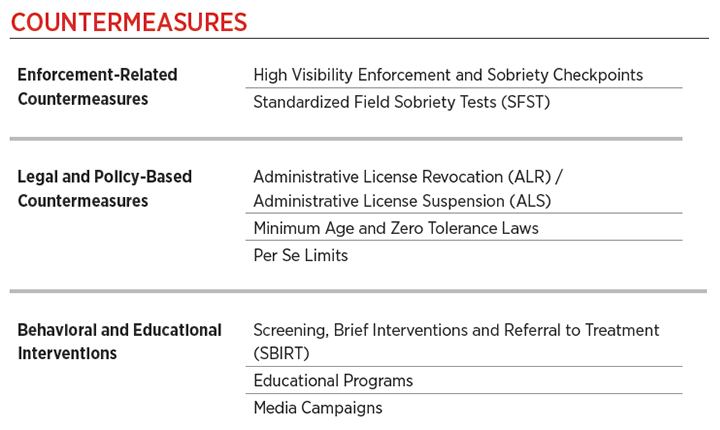
Leveraging and Enhancing Alcohol Countermeasures to Reduce Drugged Driving
Two research briefs describe a project that solicited input from subject matter experts across the U.S. regarding the potential for alcohol-impaired driving countermeasures to be adapted as drugged or drug-impaired driving countermeasures.
September 2018
Suggested Citation
For media inquiries, contact:
Tamra Johnson
202-942-2079
TRJohnson@national.aaa.com
Abstract
In contrast to alcohol-impaired driving, the available research-based evidence regarding effective countermeasures for drug-impaired driving is still nascent. These two research briefs describe a project that solicited input from subject matter experts across the United States regarding the potential for alcohol-impaired driving countermeasures to be adapted as drugged or drug-impaired driving countermeasures.
Introduction
The effect of alcohol on crash risk has been well studied. Today, experts rely on proven measurement techniques to assess alcohol levels and have extensively examined how alcohol affects driving behavior. Research and data collection on drugs other than alcohol is not as far advanced, in part because of the sheer number of available drugs — whether prescription, over-the-counter, or recreational — as well as the myriad potential interaction effects when multiple drugs are used. The available evidence suggests that many people drive with drugs other than alcohol present in their system. Unfortunately, in contrast to alcohol-impaired driving, the available research-based evidence regarding effective countermeasures for drug-impaired driving is still nascent. That said, it is possible that data and experiences from the alcohol-impaired driving arena can be leveraged to advance the suite of countermeasures against drugged driving. This research brief describes a project that solicited input from subject matter experts (SMEs) across the United States regarding the potential for alcohol-impaired driving countermeasures to be adapted as drugged or drug-impaired driving countermeasures. Throughout, the term ‘drug’ refers to any type of substance other than alcohol that can contribute to impaired driving. The outcomes from the project were grouped into three categories of countermeasures: enforcement-related countermeasures, legal- and policy-based countermeasures, and behavioral and educational interventions. One brief describes enforcement-related and legal- and policy-based approaches, while a second brief describes behavioral and educational approaches.
Methodology
The purpose of this project was to solicit input regarding current alcohol countermeasures that could be used to reduce drug-impaired driving. Over the course of the project, five workshops were held (Washington, D.C.; Atlanta, Georgia; Denver, Colorado; Irvine, California; and Seattle, Washington) between June and August 2016. Seventy-seven SMEs participated in these workshops. These groups included experts from a variety of fields, including traffic safety, law enforcement, toxicology, advocacy, substance abuse treatment, and alcohol and cannabis licensing. To guide the discussion, the SMEs were provided with a list of countermeasures, including those in the domains of enforcement, legislation, and education. They were also encouraged to bring new ideas to the table. In identifying those countermeasures that could potentially help reduce drug-impaired driving, SMEs were asked to consider the impact on driving behavior as well as potential for rapid adoption.
Results
A brief description of each countermeasure is provided in the respective research brief, along with some relevant background literature, followed by the strengths and limitations as well as recommendations for potential application to drug-impaired driving based on input from the SMEs.
Suggested Citation
For media inquiries, contact:
Tamra Johnson
202-942-2079
TRJohnson@national.aaa.com
